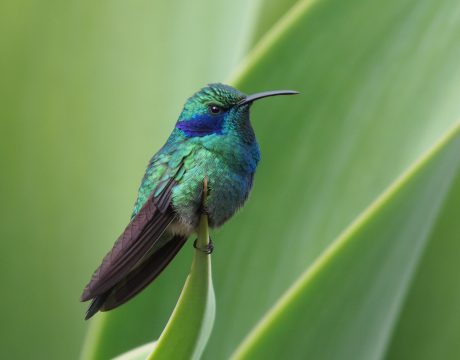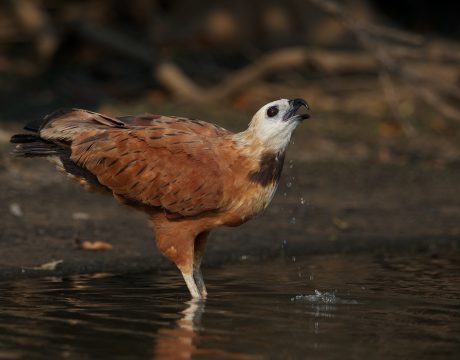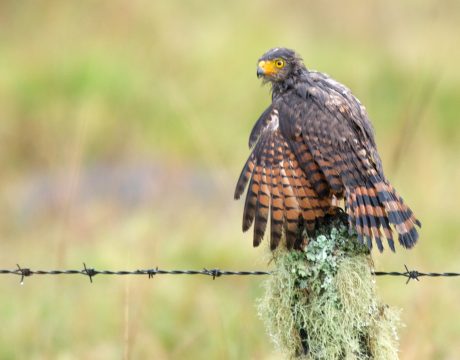Return of Bird of the Week: Black-crested Coquette
There’s a sub-family of hummingbirds called Coquettes, in the genus Lophornis. The Black-crested Coquette is the northernmost of the ten members of that sub-family. Andit’s a pretty spectacular little bird. Only the showy male has the fancy hairdo. The species ranges from southeastern Mexico to eastern Costa Rica, Black-crested is the only species of coquette to inhabit the Atlantic slope of Middle America. There’s also a small population of this species on the Pacific slope in the northern portion of its range. Black-crested Coquette prefers semi-open forested areas, second growth and plantations, and usually forages in the canopy by trap-lining…
Return of Bird of the Week: Velvet-purple Coronet
From the back, the male Velvet Purple Coronet is interesting. (These photos are from 2009, when WC was shooting with an Olympus E-3, a camera that was purely incapable of achieving sharp focus. Maddening. So the images aren’t as crisp as WC might like.) But from the front, the male Velvet-purple Coronet is spectacular. In addition to their sometimes spectacular colors, some hummingbirds have wonderful names. Like “Coronet.” The species has a limited range, in the cloud forests on the Pacific slopes of the Andes in Columbia and Ecuador, in a narrow band in the middle altitudes. Though unique enough…
Return of Bird of the Week: Lesser Violetear
You can never have too many hummingbirds. The Lesser Violetear was formerly lumped with its Mexican cousin as the Green Violetear. In 2016, the Green Violetear was split into the Mexican Violetear (Nicaragua north to Mexico) and the Lesser Violetear (Costa Rica south to Bolivia). If you’re a lister, it’s an armchair bird added to your life list. Lesser Violetear inhabits highland humid forest borders, clearings and highland pastures, and is resident throughout its range. It’s a pretty common feeder bird. Like most hummingbirds, this is a nectar feeder, adding insects to its diet primarily when feeding young. it lays…
Return of Bird of the Week: Booted Racket-tail
After a couple of months of raptors, it’s time for a change. And among avifauna, it’s hard to make a bigger change than to move from raptors to hummingbirds. The Western Hemisphere’s “flying jewels” are marvelous, colorful and extraordinarily varied, as WC will attempt to show over the next few months. Some of them also have pretty cool names. We’ll start with a species that checks all those boxes: the Booted Racket-tail. The first thing you notice about this species is the tail. It’s longer than the bird, and ends in a pair of “rackets,” elongated feathers tipped with blunt…
Return of Bird of the Week: Great Black Hawk
It’s black. It’s big. It’s a hawk. Therefore, it’s a Great Black Hawk. Another complete failure of imagination by the folks who name birds. With a wing span of well over a 3.5 feet and a body length of more than two feet, this is a large raptor. The long, bright yellow legs, white tail band and two-tone bill make the bird unmistakeable in the field. This species is a generalist, pretty much willing to eat anything it can catch. But it is most commonly found along rivers; in fact, this photo was taken from a dugout, in the upper…
Return of Bird of the Week: Variable Hawk
Not all bird species are aptly named. But the Variable Hawk certainly is. The cinnamon color in these two photos is likely the least common color phase, which ranges from whitish to very dark gray. Some ornithologists describe it as the most variable hawk in the world in coloration. At least 27 distinct adult plumages are known in this species. Across all plumages, it has a whitish tail with a strong, black terminal band. It varies in size, too, ranging from 18 inches to 25 inches in length. The taxonomy of the species is not well understood, either. Currently, it’s…
Return of Bird of the Week: Crane Hawk
The Crane Hawk is a medium-sized accipter with a very wide distribution, extending from Mexico to northern Argentina. While it is never found in large numbers across that extended range, there are believed to be about 50,000 birds. But that’s guess; surprisingly little is known about the species. The most notable feature of this species are those very long legs. The legs are nearly unique among raptors in that they are “double-jointed,” able to bend in both directions. Stated technically, it has an intertarsal joint that allows flexible forward and backward bending of its legs The leg length, long outside talons…
Return of Bird of the Week: Black-collared Hawk
It’s a gorgeous bird, bright cinnamon with thin black lines, a white head and the black bib that gives the species its common name. It’s unmistakeable in the field. And while it is an Accipter – like a Sharp-shinned or Cooper’s Hawk in North America – it’s evolved into a different ecological niche entirely. This is the Neotropics’ analogue to an Osprey, a species that primarily hunts and feeds on fish. It’s widely distributed, from Mexico to Argentina. As you’d expect from its diet, it is most frequently found along waterways, but rarely at high densities. It’s monotypic – the…
Gov. wants to know if you’re “done venting” yet
You could practically hear the eye rolling as he stared at his watch. It’s hard to say when that might be; are we “done venting” about the horrendous cuts to the university system? Are we “done venting” about skyrocketing charges at the Pioneer Homes? Are we “done venting” at incompetent, partisan cronies, and conservative talk radio hacks making six figures? Are we “done venting” about disingenuous promises used to get into office? Are we “done venting” at extreme cuts to Medicaid, homeless services, pre-K, agriculture programs, and public safety? Thumbing his nose at the Constitution and rights of workers?…
Return of Bird of the Week: Roadside Hawk
Ubiquitous in Central and South America, and easily seen because it prefers forest edges, including roadsides, it might be the most commonly seen raptor across its range. It’s certainly been a rare trip to the Neotropics that WC hasn’t seen one. This Roadside Hawk’s effort to dry out nicely displays the rufous patches in the wings and the strong barring in the tail, distinctive field marks for this species. This is a small raptor, averaging about the size of a Cooper’s Hawk, but with rounded, slightly stubby wings. It’s arguably the smallest Buteo. This species is a generalist, adapting to…














